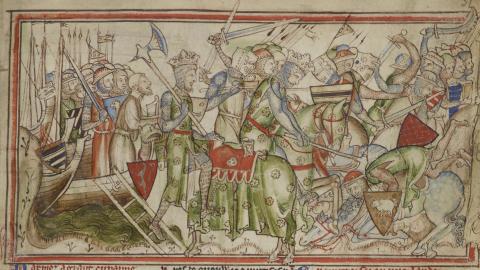The largest seaborne invasion in history: The story of D-Day
By June 1944, over two million troops had gathered in Britain for the invasion.
On 6 June 1944, Allied forces crossed the English Channel and headed towards Normandy, France, starting the largest seaborne invasion in the history of warfare. D-Day, which in military terminology means the day that an operation will begin, was codenamed Operation Neptune, the assault phase of the wider campaign known as Operation Overlord - the Allied invasion of German-occupied Western Europe during WWII.
Planning for the invasion dated back as early as 1941 but it wasn’t until the May 1943 Trident Conference held in Washington that the Allies committed to a cross-channel attack within the next year.
In November 1943, Winston Churchill, Franklin D. Roosevelt and Joseph Stalin met for the Tehran Conference. The Soviet leader had been a strong advocate for the Allies to open up a second front in Western Europe to relieve pressure on his forces in the East. He was pleased to hear Operation Overlord had been given a provisional date of May 1944.
With increased Allied air superiority over the skies of Western Europe and the securing of the all-important Atlantic supply routes, planning for Operation Overlord could enter its next phase. Scarred by the failed assault on Dieppe in 1942, the British favoured a less direct approach into Europe, wanting to enter via the Mediterranean or the Balkans. However, the Americans wanted the shortest route possible to Germany and considering they were supplying the majority of the men and equipment overruled the British.
Eventually, the sheltered coastline of Normandy was chosen as the landing point. Although further from Germany than the Pas de Calais, the idea was that the wide-open Normandy beaches would make landing vehicles and supplies easier, whilst the region offered a broader range of expansion with tactical targets such as the ports of Cherbourg and Le Havre close by.
Since 1942, German forces under the command of Field Marshal Erwin Rommel, 'the Desert Fox', had constructed a series of defences that stretched along the coastlines of Scandinavia down Western Europe to the Spanish border. It was known as the ‘Atlantic Wall’. Therefore, the success of the invasion on Hitler’s Fortress Europe required meticulous operational planning unlike anything seen before.
Deception played a pivotal role in the build-up to D-Day. Operation Fortitude, part of the wider Operation Bodyguard, aimed to confuse the Germans about when and where an Allied invasion on Europe might take place.
Tactics included the creation of fake army camps in Kent, complete with inflatable tanks to give the impression to Hitler that a sizeable force was building in the South East of Britain, with the Pas de Calais as the most likely landing point. To further sell the bluff, famed American General George S Patton, who was well respected by German high command, was given command of the fictitious First U.S. Army Group. Combined with false radio traffic and information fed back to the Germans via the Double-Cross System (German spies working for the Allies as double agents), Hitler re-enforced the Pas de Calais and remained oblivious to the Allies true intentions.
Extensive training exercises began as early as 1943 to prepare the Allied forces for the amphibious invasion. Not all went to plan. In April 1944 on Slapton Sands beach in Devon, friendly fire combined with a surprise attack from German E-boats caused the deaths of 749 American servicemen during Exercise Tiger.
In the months leading up to D-Day, aerial reconnaissance of the Normandy coastline helped the Allies dissect the German defences. Allied bombing of German factories in France, Belgium and Germany reduced the capabilities and numbers of the Luftwaffe whilst the striking of road and rail lines severely weakened the German communication and supply routes. The bombing was codenamed Operation Transportation and it aimed to cut Normandy off from being effectively resupplied by German forces.
By June 1944, over two million troops had gathered in Britain for the invasion. Although British, American and Canadian troops made up the bulk of the force, over 12 countries were represented with infantry.
The invasion was planned for 5 June, however poor weather conditions forced the Supreme Commander of Allied forces, General Dwight D. Eisenhower, to postpone the invasion by 24 hours. The weather was so poor that Rommel even returned to Germany to celebrate his wife's 50th birthday, convinced any Allied attack was most unlikely.
The largest invasion force ever assembled of around 7,000 vessels made its way across the English Channel towards Normandy.
A small break in the weather allowed for a window of opportunity on 6 June, Eisenhower gave the go-ahead for the operation to begin. Allied command waited with bated breath, they expected high casualty figures and even Eisenhower had prepared a speech accepting full responsibility if the landings failed.
In the early hours of 6 June, Allied aircraft dropped aluminium foil strips known as ‘Window’ near the Pas de Calais convincing German radar a large invasion force was on its way there. In fact, the largest invasion force ever assembled of around 7,000 vessels made its way across the English Channel towards Normandy.
Under the cover of darkness, Paratroopers descended behind the lines to cut German communication systems, secure bridges, destroy coastal defence batteries and secure the flanks of the invasion area.
Whilst Utah was secured with relative ease, Omaha was a different story. With terrain suited to the defender, amphibious tanks lost to the surf and fierce German defence from battle-hardened troops, the situation looked so grim for the Allies that the attack on the beach was nearly called off. In the end, dogged determination by the American troops led to the eventual exploitation of gaps in the German defence. By the day's end, the beach had been secured at the loss of over 2,000 American lives.
British and Canadian troops landed on Gold, Juno and Sword beaches roughly an hour later than the Americans. Although heavy casualties were initially inflicted on those beaches, the Allies made good headway and soon began pushing inland.
As the sun set on 6 June 1944, around 4,000 Allied soldiers had perished and some 6,000 had been wounded. German deaths lay at around 1,000 men, with wounded figures estimated between 4,000 – 9,000. Although Omaha beach had proven costly for the Allies, the overstretched German defences at Normandy had been relatively easily overwhelmed by the invading force.
Confusion amongst German command further aided the Allies, as their response in the first few hours of the invasion was badly coordinated. Hitler, who had personal control of four reserve divisions, initially refused to send any reinforcements to Normandy continuing to believe it was a ruse and the main attack was still to come at the Pas de Calais.
Nearly 160,000 troops crossed the English Channel on D-Day and by the end of June, nearly a million had landed on French soil. Although the D-Day landings failed to secure any of their objectives on the first day with all targeted German towns still under German control and only two of the beachheads linked up (Juno and Gold), it gave the Allies a well-needed foothold.
At 6 pm on D-Day, Winston Churchill spoke to the House of Commons declaring the day a roaring success. For the first time since the evacuation of Dunkirk in mid-1940, the Allies now had a significant presence in Western Europe. The Normandy bridgehead was the beginning of the push towards Berlin for the Western Allies. Months of hard and bloody fighting lay ahead as strong German defence made liberating Western Europe far from easy.
The race to Berlin was not only significant in bringing a swift end to the war but also from preventing the entire continent of Europe from turning Communist red.
The Western Allies would eventually join up with the Soviets in Germany and on 8 May 1945, the Germans officially surrendered - Hitler having taken his own life a week earlier in his Führerbunker in Berlin.
















